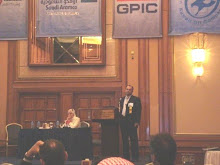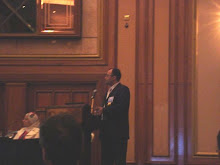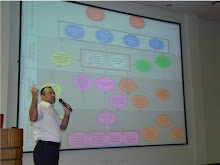This discussion presents my viewpoint of when many organizations come to a position of assessing maturity improvements in Project management; along with pros and cons of adopting a PM Maturity Level and finally the challenge of 'guiding organizational change' to the desired higher level. (pros and cons of what and how)
Unfortunately, in many organizations, the choice of implementing a maturity model is reactively assessed after few cycles of undesired outcomes (handling bigger more complex projects with the same way we used to do for small sized ones, the gap in PM practice increases and thus money slips from cracks and we end up losing). I have witnessed that it’s at this stage that most organizations here in Saudi Arabia start looking at better practices.
Pros and cons of maturity models get their roots from those of PM methodologies. Since models are the framework upon which PM methodologies are planned to “ascend”, they share most of the pros and cons when it comes to implementations.
While on one hand, these models are seen as overhead, they are considered as complicating what can be done easier or simply an external pre-requisite (certification) to be able to bid for bigger projects.
On the other hand, they provide a comprehensive set of standards that close all gaps, standardize practices around the organization; MM are means for using previously tested blocks instead of reinventing the wheels.
By using these models, we can choose the framework that fits our business/industry (maturity model), know the PM practices that are adequate to our projects’ scale and complexity (maturity level); then develop our PM processes, procedures, practices, etc (PM methodology) that improves our PM capability to drive our projects to successful conclusions.
Maturity models encounter having to shift this methodology into higher more mature levels that generally develop standardization, structuring, formality, cultural aspects, and the like. Since implementation needs “change”, this is where new pros and cons emerge.
Managing resistance to change; shortening the ‘dark valley’ characterized by the learning period between implementing changes and realizing their benefits; Performing cultural alignment when the model encounters more emphasis on aspects that don’t align with the organizational culture. All these are big challenges that need to be addressed when we consider such a shift.
As for the benefits, how about a real life situation?
For a reputable structure organization, we are currently implementing an organization-wide ERP project to help automate practices and increase visibility. At the same time, there is a boom in the market and projects undertaken are scaling up by 300%. The designated new processes should be developed, with the help of an external consultant, to improve PM capabilities and enable ERP data to be captured. With no reference to a maturity model / maturity level, we are finding it very difficult to answer questions like:
• Did we capture the full picture of project management requirements that we should be benchmarking upon?
• Do we know the gaps in our project performance, and their extent?
• Shall we emphasize more on processes and procedures or cultural aspects?
• Are we in a good position to be involved in joint ventures, partnering or even strategic partnering? Shall we set a partnering framework and procedures to implement with our sister organizations?
• Can we agree to what degree should we formalize, standardize, measure, and structure our processes?
• How can we align the IT perspective of ERP implementation with the business perspective of finance and the project management perspective?
• And the list goes on.
I believe that if we adopted a maturity model like RMMM (Relationship Management Maturity Model) or OPM3; even a combination of maturity models that complement each others in a way to align with our organizational strategic decision, answering such questions would be less challenging.
About The Author

- Eng. Samer el Barakeh, MPM, PMP
- Samer el Barakeh was born in Lebanon, 1973. He completed his Bachelor in Engineering-CCE at Beirut Arab University-Lebanon in 1996 with honours. Samer was granted Masters Degree in Project Management (MPM) from the University of Sydney-Australia with honours. He also gained the Project Management Professional (PMP) Credential from The Project Management Institute (PMI). Samer is a member of the Order of Architects and Engineers in Lebanon since 1996, The Project Management Institute (PMI), Arabian Gulf Chapter (AGC-PMI) and Lebanon Chapter-PMI. During his 13 years of professional experience in Lebanon, Australia and Saudi Arabia, Samer held many positions among them: Telecommunication Site Engineer, Site Manager, Low Current Service Head, and he is currently Senior Systems Analyst at the General Project Construction Division. Samer is a Project Management Consultant and Training Provider for universal organizations like Business Management Consultants (USA) www.bmc-online.com and PMCTQuest (Canada) www.pmctquest.com Samer is a Registered Training Provider for Project Management Professional (PMP), and he provides training in Program Management, Portfolio Management,PMO...
Select a topic to view content
- A comparison between PMBOK and Prince2 Methodologies and reflection on case study examples (1)
- ABC to Avoid Project Failure (1)
- Business Case and Quantitative Benefits (1)
- Do we need more 'Planners' ? (1)
- Fasilitator in Partnering-A Coincise Shot (1)
- How to Ensure Stratgic Alignment of Our Projects? (1)
- Individual Dissimilarity and Team Work (1)
- Knowledge Management (1)
- Maturity Models-The Pros and Cons (1)
- Organizational Advantages from Partnering (1)
- Organizational Maturity: Lets Head Upwards... (1)
- Organizational Strategy and Project Alignement (1)
- Practical Solutions 1 of 6: Introduce RMMM (1)
- Practical Solutions 2 of 6: Facilitate Change to Perk up Maturity (1)
- Practical Solutions 3 of 6: Leverage Organisational Culture Barrier (1)
- Practical Solutions 4 of 6: Organisational Cultural Alignment (1)
- Practical Solutions 5 of 6: Defining a Unified Decision Making Tool (1)
- Practical Solutions 6 of 6: Understanding The Paradox of Control (1)
- Programme Management to Implement Strategy (1)
- Project Management and Construction Management (1)
- Project Managers relocated before Proper Project Closure and Learning Lessons (1)
- Project Managers' Power (1)
- Strategic Planning (1)
- Successful Project Management Office-PMO (1)
- System Thinking: Archetypes at Work... (1)
- The Partnering Change Process (1)
- The Upper Hand… Leadership skills or Processes? (1)
- Thinking about change needed? Maybe you should be more ‘worried’ about how to make it real (1)
- Vision Mission and Objectives What and Why? (1)
- What is meant by Portfolio and Programme Management (1)
- Why Partnering in Organizations? (1)
March 23, 2008
Maturity Models, The Pros and Cons
Posted by
Eng. Samer el Barakeh, MPM, PMP
at
10:08 AM
![]()
![]()
Subscribe to:
Post Comments (Atom)
Followers
All Titles
A comparison between PMBOK and Prince2 Methodologies and reflection on case study examples
ABC to Avoid Project Failure
Business Case and Quantitative Benefits
Do we need more 'Planners' ?
Fasilitator in Partnering-A Coincise Shot
How to Ensure Stratgic Alignment of Our Projects?
Individual Dissimilarity and Team Work
Knowledge Management
Maturity Models-The Pros and Cons
Organizational Advantages from Partnering
Organizational Maturity: Lets Head Upwards...
Organizational Strategy and Project Alignement
Practical Solutions 1 of 6: Introduce RMMM
Practical Solutions 2 of 6: Facilitate Change to Perk up Maturity
Practical Solutions 3 of 6: Leverage Organisational Culture Barrier
Practical Solutions 4 of 6: Organisational Cultural Alignment
Practical Solutions 5 of 6: Defining a Unified Decision Making Tool
Practical Solutions 6 of 6: Understanding The Paradox of Control
Programme Management to Implement Strategy
Project Management and Construction Management
Project Managers relocated before Proper Project Closure and Learning Lessons
Project Managers' Power
Strategic Planning
Successful Project Management Office-PMO
System Thinking: Archetypes at Work...
The Partnering Change Process
The Upper Hand… Leadership skills or Processes?
Thinking about change needed? Maybe you should be more ‘worried’ about how to make it real
Vision Mission and Objectives What and Why?
What is meant by Portfolio and Programme Management
Why Partnering in Organizations?

















Great post!
ReplyDeleteAs a Project Manager, every now and then, we need to assess our work and improve our way of dealing with projects because our world is gradually changing and developing.
This post is very informative. Thanks for posting!